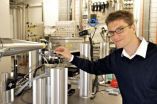(Press-News.org) Understanding how the brain recognizes objects is a central challenge for understanding human vision, and for designing artificial vision systems. (No computer system comes close to human vision.) A new study by MIT neuroscientists suggests that the brain learns to solve the problem of object recognition through its vast experience in the natural world.
Take for example, a dog. It may be sitting nearby or far away or standing in sunshine or shadow. Although each variation in the dog's position, pose or illumination produces a different pattern of light on the retina, we still recognize it as a dog.
One possible way to acquire this ability to recognize an object, despite these variations, is through a simple form of learning. Objects in the real world usually don't suddenly change their identity, so any two patterns appearing on the retina in rapid succession likely arise from the same object. Any difference between the two patterns probably means the object has changed its position rather than having been replaced by another object. So by simply learning to associate images that appear in rapid succession, the brain might learn to recognize objects even if viewed from different angles, distances, or lighting conditions.
To test this idea, called "temporal contiguity," graduate student Nuo Li and associate professor James DiCarlo at MIT's McGovern Institute for Brain Research "tricked" monkeys by exposing them to an altered visual world in which the normal rules of temporal contiguity did not apply. They recorded electrical activity from individual neurons in a region of the monkey brain called the inferior temporal cortex (IT), where object recognition is thought to happen. IT neurons respond selectively to particular objects; a neuron might, for example, fire more strongly in response to images of a Dalmatian than to pictures a rhinoceros, regardless of its size or position on the retina.
In the new study, which appears in the Sept. 23 issue of Neuron, monkeys observed an object on a computer screen as the object became larger or smaller, as though it were approaching or receding from view. But in some cases, the researchers replaced an object with another as it changed in size. For example, as a Dalmatian became larger on the screen, it suddenly transformed into a rhinoceros.
"We know that IT neurons are involved in object recognition, so our prediction was that these neurons would become confused," explains Li. "By exposing them to this artificial visual experience, we undermined the regularities that we hypothesized teach neurons to recognize the object at multiple sizes."
After a few hours, each IT neuron did indeed become confused. For example, a neuron that preferred a dog over a rhino (regardless of size) began to lose this preference specifically among large dogs and large rhinos (the size at which the temporal contiguity rules had been broken by the researchers). In some cases, the object preferences even started to reverse, and the neuron would begin to prefer large rhinos over large dogs. In other words, the altered visual experience was not merely degrading existing patterns of selectivity but also creating new ones. The new results offered the strongest support yet for the "temporal contiguity" hypothesis of object representation.
"Our monkeys saw only a few hundred examples of these altered visual stimuli during the experiment," says DiCarlo. "If we extrapolate to a lifetime of visual experience, we think this effect is a major contributor to object constancy."
In earlier work, Li and DiCarlo had shown a similar effect when object identities were switched during eye movements. "But we couldn't tell whether that result was peculiar to eye movements – for example, you don't need eye movements to observe a large image of a car changing into a small image of the same car," says DiCarlo. "Our new results strongly suggest that this is a general mechanism for learning about object identity across a wide range of real-world conditions."
The researchers did not measure the monkeys' behavior during the new study, so it is not known whether the monkeys themselves become confused by the altered visual experience. But similar effects have been seen in human studies, and it seems likely that the changing pattern of neural activity would lead to changes in perceptual judgments. DiCarlo and colleagues plan to test this in future studies.
INFORMATION:
Source: "Unsupervised natural visual experience rapidly reshapes size invariant object representation in inferior temporal cortex," by Li N, DiCarlo JJ. Neuron. 23 Sept 2010.
Funding: McGovern Institute for Brain Research at MIT, McKnight Endowment Fund for Neuroscience, and NIH.
MIT neuroscientists reveal how the brain learns to recognize objects
2010-09-22
ELSE PRESS RELEASES FROM THIS DATE:
Acetylation may contribute to dementia and Alzheimer's disease
2010-09-22
A new study uncovers a protein modification that may contribute to the formation of neuron-damaging neurofibrillary tangles in the human brain. The research, published by Cell Press in the September 23 issue of the journal Neuron, may lead to new strategies for treatment of neurodegenerative diseases that result from pathological aggregation of tau protein.
Tau protein is common in the central nervous system where it helps to stabilize microtubules that form the neuronal cytoskeleton. Tau mutations have been linked with dementia and Alzheimer's disease (AD), and accumulation ...
Getting off tract: Polyglutamine disease involves other regions of protein
2010-09-22
Many genes code for proteins that have a "polyglutamine tract," several glutamine amino acid residues in a row. Nine inherited neurodegenerative diseases, including Huntington's disease and spinocerebellar ataxia type 1 (SCA1), are associated with mutations that cause abnormally long polyglutamine tracts. One theory suggests that accumulation of proteins with extra glutamines damages and kills neurons. However, there is evidence that glutamine tract expansion alone is not sufficient to cause disease.
Now, new research published by Cell Press in the September 23 issue ...
Amazing horned dinosaurs unearthed on 'lost continent'
2010-09-22
Two remarkable new species of horned dinosaurs have been found in Grand Staircase-Escalante National Monument, southern Utah. The giant plant-eaters were inhabitants of the "lost continent" of Laramidia, formed when a shallow sea flooded the central region of North America, isolating the eastern and western portions of the continent for millions of years during the Late Cretaceous Period. The newly discovered dinosaurs, close relatives of the famous Triceratops, were announced today in PLoS ONE, the online open-access journal produced by the Public Library of Science.
The ...
Salmonella creates environment in human intestines to foster its own growth
2010-09-22
A study led by researchers at UC Davis has found how the bacteria Salmonella enterica — a common cause of food poisoning — exploits immune response in the human gut to enhance its own reproductive and transmission success. The strategy gives Salmonella a growth advantage over the beneficial bacteria that normally are present in the intestinal tract and promotes the severe diarrhea that spreads the bacteria to other people.
The findings are published in the Sept. 23 issue of the journal Nature.
"The human body normally has 10 times more microbes than human cells that ...
Scientists reveal structure of dangerous bacteria's powerful multidrug resistance pump
2010-09-22
LA JOLLA, CA – September 20, 2010 –– A team at The Scripps Research Institute has detailed the structure of a member of the only remaining class of multidrug resistance transporters left to be described. The work has implications for combating dangerous antibiotic resistant strains of bacteria, as well as for developing hardy strains of agricultural crops.
The study was published in an advance, online issue of the journal Nature on September 22, 2010.
"Now with our crystal structure, scientists can for the first time figure out exactly how this transporter works," ...
New computer-tomography method visualizes nano-structure of bones
2010-09-22
Osteoporosis, a medical condition in which bones become brittle and fragile from a loss of density, is among the most common diseases in aging bones: In Germany around a quarter of the population aged over 50 is affected. Patients' bone material shrinks rapidly, leading to a significantly increased risk of fracture. In clinical research to date, osteoporosis is diagnosed almost exclusively by establishing an overall reduction in bone density. This approach, however, gives little information about the associated, and equally important, local structure and bone density changes. ...
Physical limitations of breast cancer survivors
2010-09-22
Women who survive breast cancer often suffer from functional limitations that affect motion, strength and dexterity, which may adversely affect all-cause and competing-cause survival but not breast cancer survival, according to a study published online September 22 in The Journal of the National Cancer Institute.
Breast cancer survivors who have functional limitations that affect motion, strength, and dexterity are at the same risk of dying from a recurrence of breast cancer as physically fit survivors, but are more likely to die from other causes.
Breast cancer survivorship ...
Gladstone scientists identify strategy to reduce toxic proteins associated with Alzheimer's disease
2010-09-22
SAN FRANCISCO, CA—September 23, 2010—Scientists at the Gladstone Institute of Neurological Disease (GIND) have uncovered new approaches to reduce toxic proteins in Alzheimer's disease (AD) and other neurodegenerative diseases. The results might lead to new treatments for these diseases.
"We examined a protein called tau that has been strongly implicated in Alzheimer's disease," said Li Gan, PhD, senior author on the study. "Tau forms toxic protein aggregations in the brains of Alzheimer patients."
Tau is a common protein in the central nervous system where it helps ...
Ocean cooling contributed to mid-20th century global warming hiatus
2010-09-22
FORT COLLINS – The hiatus of global warming in the Northern Hemisphere during the mid-20th century may have been due to an abrupt cooling event centered over the North Atlantic around 1970, rather than the cooling effects of tropospheric pollution, according to a new paper appearing today in Nature.
David W. J. Thompson, an atmospheric science professor at Colorado State University, is the lead author on the paper. Other authors are John M. Wallace at the University of Washington, and John J. Kennedy at the Met Office and Phil D. Jones of the University of East Anglia, ...
Cell division typically associated with cancer may also protect the liver from injury
2010-09-22
PORTLAND, Ore. — Researchers at Oregon Health & Science University have discovered that a form of cell division typically associated with cancer called multipolar mitosis can yield diverse, viable cells capable of protecting the liver from injury and poisonous substances, such as pesticides, carcinogens or drugs. Their findings are published online in the journal Nature.
"Our findings show that the liver, which is known to have a tremendous capacity for regeneration, also has an amazing degree of diversity. A better understanding of this process may reveal why some individuals ...


